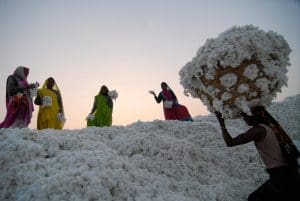Textile Exchange (TC) has released its second annual 2025 Sustainable Cotton Challenge report. The purpose of the 2025 Challenge is to raise the uptake of organic and preferred cotton, which can increase smallholder farmers’ income, eliminate hazardous pesticides, reduce the use of water, pesticides and synthetic fertilizers, and improve water quality and soil health.
The Challenge was formed in 2017 when His Royal Highness The Prince of Wales convened a group of chief executive officers (CEOs) through the work of his International Sustainability Unit that existed to address critical challenges facing the world.
Those original 13 CEOs committed to working together to accelerate the use of sustainable cotton, which paved the way for other industry leaders to follow, resulting in 82 companies now committed to sourcing 100 per cent sustainable cotton by 2025.
 The Challenge serves as a cornerstone for change in the apparel and textile industry by encouraging brands and retailers to increase the uptake of organic and preferred cotton, which has the ability to increase the income of smallholder farmers, eliminate highly hazardous pesticides, eliminate or reduce the amount of pesticides and synthetic fertilizer used, reduce water use and improve water quality and soil health, zero carbon foot prints resulting in sustainability by 2025.
The Challenge serves as a cornerstone for change in the apparel and textile industry by encouraging brands and retailers to increase the uptake of organic and preferred cotton, which has the ability to increase the income of smallholder farmers, eliminate highly hazardous pesticides, eliminate or reduce the amount of pesticides and synthetic fertilizer used, reduce water use and improve water quality and soil health, zero carbon foot prints resulting in sustainability by 2025.
Today, 22 per cent of the world’s cotton is more sustainable. By 2025, it is the vision of the 2025 Challenge that more than 50 per cent of the world’s cotton is converted to more sustainable growing methods.
One of the key focuses going forward will be to drive continuous improvement across the initiatives with a focus on best practices for soils. Implementing regenerative practices, which puts carbon back into the soil, is a key investment farmers can make to mitigate and reduce the climate crisis, said by TC

Brands and retailers joining the challenge and committing to source more sustainable cotton can choose from Textile Exchange’s list of recognized organic and sustainable cotton initiatives. These initiatives include ABRAPA, Better CottonInitiative (BCI), Cotton made in Africa (CmiA), Recycled Cotton, Organic Cotton, BASF e3, Fairtrade Organic, Cleaner Cotton, Fairtrade, Transitional Cotton, United States Cotton Trust Protocol Field to Market, ISCC, myBMP, REEL Cotton, Regenerative Cotton. By committing to using cotton from these initiatives and standards, the brands are ensuring that the intentions of their sustainable sourcing strategies are maintained and the integrity of their commitments uncompromised.

Of the 82 signatories of the 2025 Challenge, 73 participated in the 2019 Corporate Fibre and Materials Benchmark programme to report on their progress towards their goal of 100 per cent cotton being sourced from the approved initiatives by 2025.
While 27.5 per cent signatories of the 2025 Challenge has achieved their 2025 target of 100 per cent preferred cotton usage, all of which are organic, the same percentage has achieved a preferred cotton share of between 75 per cent and 99 per cent.
A quarter has achieved a preferred cotton share of between 50-74 per cent, while 15 per cent has achieved a preferred cotton share of in the range 25-49 per cent.
30 additional brands and retailers and 5 manufacturers are participating, and their sustainable cotton usage is up by 19 percent.

